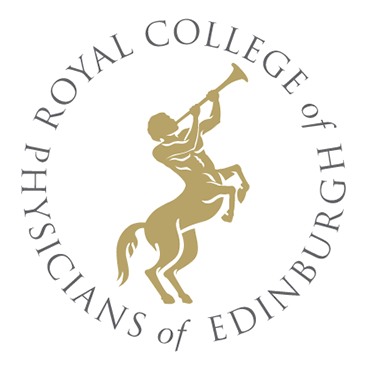
The Consultation Letters of Dr William Cullen (1710-1790) at the Royal College of Physicians of Edinburgh
[ID:691] From: Dr William Cullen (Professor Cullen) / To: [ADDRESSEE UNKNOWN] / Regarding: Sir John Cathcart (Patient) / 28 December 1782 / (Outgoing)
Reply regarding Sir John Cathcart's ongoing illness. Cullen suggests 'there is much reason to suspect that some part of the hydropic diathesis may remain'. He also discusses mercury: 'It is possible and even probable that the Hydrocephalus of Infants has been cured by a Solution raised by Mercury, but I take the Hydrocephalus of Infants to be a very different disease'.
- Facsimile
- Normalized Text
- Diplomatic Text
- Metadata
- Case
- People
- Places
Facsimile
There are 4 images for this document.
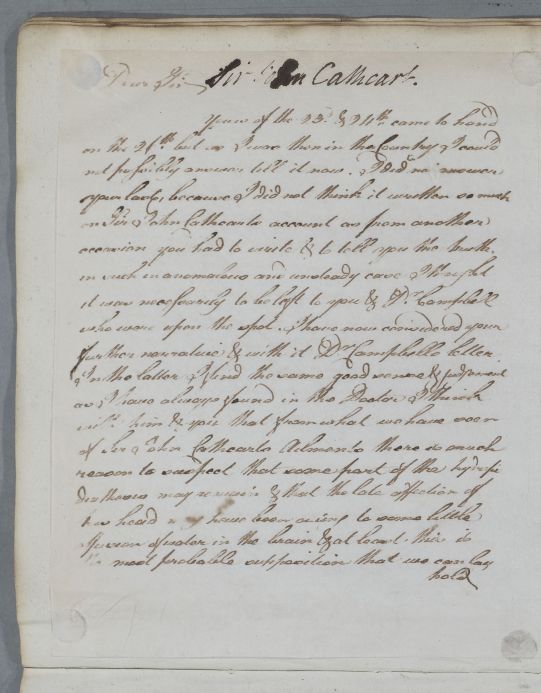
[Page 1]
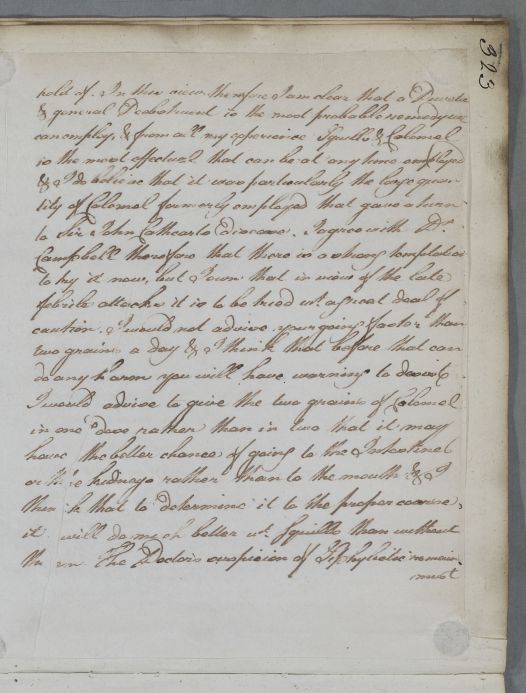
[Page 2]
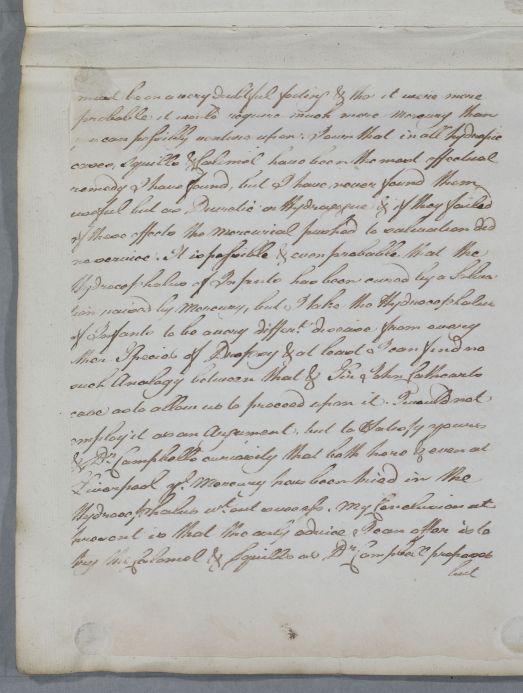
[Page 3]
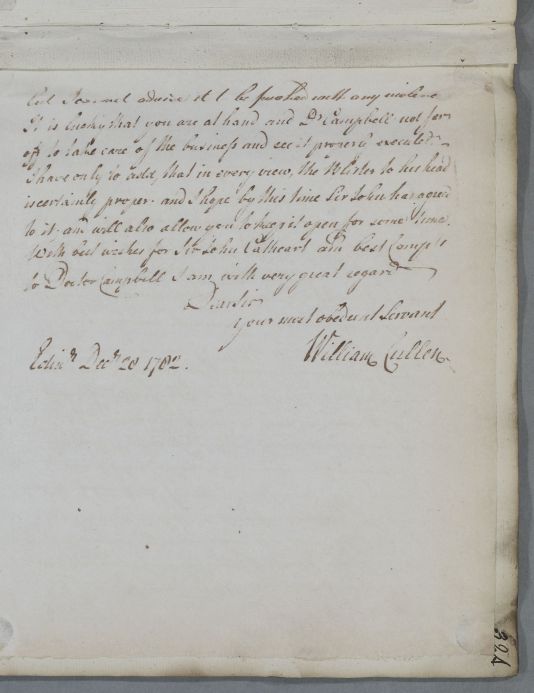
[Page 4]
Metadata
| Field | Data |
|---|---|
| DOC ID | 691 |
| RCPE Catalogue Number | CUL/1/1/15/178 |
| Main Language | English |
| Document Direction | Outgoing |
| Date | 28 December 1782 |
| Annotation | None |
| Type | Machine copy |
| Enclosure(s) | No enclosure(s) |
| Autopsy | No |
| Recipe | No |
| Regimen | No |
| Letter of Introduction | No |
| Case Note | No |
| Summary | Reply regarding Sir John Cathcart's ongoing illness. Cullen suggests 'there is much reason to suspect that some part of the hydropic diathesis may remain'. He also discusses mercury: 'It is possible and even probable that the Hydrocephalus of Infants has been cured by a Solution raised by Mercury, but I take the Hydrocephalus of Infants to be a very different disease'. |
| Manuscript Incomplete? | No |
| Evidence of Commercial Posting | No |
Case
Cases that this document belongs to:
| Case ID | Description | Num Docs |
|---|---|---|
| [Case ID:960] |
Case of Sir John Cathcart whose spitting of blood implies a fatal consumptive condition. |
3 |
People linked to this document
| Person ID | Role in document | Person |
|---|---|---|
| [PERS ID:1] | Author | Dr William Cullen (Professor Cullen) |
| [PERS ID:2988] | Patient | Sir John Cathcart |
| [PERS ID:336] | Patient's Physician / Surgeon / Apothecary | Dr Ivie Campbell |
| [PERS ID:1] | Patient's Physician / Surgeon / Apothecary | Dr William Cullen (Professor Cullen) |
Places linked to this document
| Role in document | Specific Place | Settlements / Areas | Region | Country | Global Region | Confidence |
|---|---|---|---|---|---|---|
| Place of Writing | Cullen's House / Mint Close | Edinburgh | Edinburgh and East | Scotland | Europe | certain |
| Mentioned / Other | Liverpool | North-West | England | Europe | certain |
Normalized Text
Sir John Cathcart.
Dear Sir
Yours of the 23d. & 24th. came to hand
on the 26th. 1 but as I was then in the Country I could
not possibly answer till it now. 2 I did not answer
your last, because I did not think it written so much
on Sir John Cathcarts account as from another
occasion you had to write & to tell you the truth
in such in anomalous and unsteady case I thought
it was necessary to be left to you & Dr. Campbell
who were upon the spot. I have now considered your
further narrative & with it Dr. Campbells letter.
In the latter I find the same good sense & judgement
as I have always found in the Doctor I think
with him & you that from what we have seen
of Sir John Cathcarts Ailments there is much
reason to suspect that some part of the hydropic
diathesis may remain & that the late affection of
his head may have been owing to some little
effusion of water in the brain & at least this is
the most probable supposition that we can lay
[Page 2]
hold of. In the view therefore I am clear that a Diuretic
& general Deobstruent is the most probable remedy we
can employ, & from all my experience Squills & Calomel
is the most effectual that can be at any time employed
& I do believe that it was particularly the large quan¬
tity of Calomel formerly employed that gave a turn
to Sir John Cathcarts disease. I agree with Dr.
Campbell therefore that there is a strong temptation
to try it now, but I own that in view of the late
febrile attack it is to be tried with a great deal of
caution. I would not advise your going faster than
two grains a day & I think that before that can
do any harm you will have warning to desist.
I would advise to give the two grains of Calomel
in one dose rather than in two that it may
have the better chance of going to the Intestines
or the kidneys rather than to the mouth & I
think that to determine it to the proper course,
it will do much better with Squills than without
them. The Doctors suspicion of Siphylictic remains
[Page 3]
must be on a very doubtful footing & tho it were more
probable it would require much more Mercury than
you can possibly venture upon. I own that in all hydropic
cases, Squills & Calomel have been the most effectual
remedy I have found, but I have never found them
useful but as Diuretic or Hydragogue & if they failed
of these effects the Mercurial pushed to salivation did
no service. It is possible & even probable that the
Hydrocephalus of Infants has been cured by a saliva¬
tion raised by Mercury, but I take the Hydrocephalus
of Infants to be a very different disease from every
other Special of Dropsy & at least I can find no
such Analogy between that & Sir John Cathcart
case as to allow us to proceed upon it. I would not
employ it as an Argument, but to Satisfy your
& Dr. Campbells curiosity that both here & even at
Liverpool the Mercury has been tried in the
Hydrocephalus without success. My Conclusion at
present is that the only advice I can offer is to
try the Calomel & Squills as Dr. Campbell proposed
but
[Page 4]
but I cannot advise it to be pushed with any violence
It is lucky that you are at hand and Dr. Campbell not far
off to take care of the business and see it properly executed. -
I have only to add, that in every view, the Blister to his head
is certainly proper. and I hope by this time Sir John has agreed
to it; and will also allow you to keep it opn for some time.
With best wishes for Sir John Cathcart and best Compliments
to Doctor Campbell I am with very great regard
Dear Sir
Your most obedient Servant
William Cullen
Edinburgh December 28 1782.
Diplomatic Text
Sir John Cathcart.
Dear Sir
Yours of the 23d. & 24th. came to hand
on the 26th. 1 but as I was then in the Country I could
not possibly answer till it now. 2 I did not answer
your last, because I did not think it written so much
on Sir John Cathcarts account as from another
occasion you had to write & to tell you the truth
in such in anomalous and unsteady case I thought
it was necessary to be left to you & Dr. Campbell
who were upon the spot. I have now considered your
further narrative & with it Dr. Campbells letter.
In the latter I find the same good sense & judgement
as I have always found in the Doctor I think
with him & you that from what we have seen
of Sir John Cathcarts Ailments there is much
reason to suspect that some part of the hydropic
diathesis may remain & that the late affection of
his head may have been owing to some little
effusion of water in the brain & at least this is
the most probable supposition that we can lay
[Page 2]
hold of. In the view therefore I am clear that a Diuretic
& general Deobstruent is the most probable remedy we
can employ, & from all my experience Squills & Calomel
is the most effectual that can be at any time employed
& I do believe that it was particularly the large quan¬
tity of Calomel formerly employed that gave a turn
to Sir John Cathcarts disease. I agree with Dr.
Campbell therefore that there is a strong temptation
to try it now, but I own that in view of the late
febrile attack it is to be tried wt. a great deal of
caution. I would not advise your going faster than
two grains a day & I think that before that can
do any harm you will have warning to desist.
I would advise to give the two grains of Calomel
in one dose rather than in two that it may
have the better chance of going to the Intestines
or the kidneys rather than to the mouth & I
think that to determine it to the proper course,
it will do much better wt. Squills than without
them. The Doctors suspicion of Siphylictic remains
[Page 3]
must be on a very doubtful footing & tho it were more
probable it would require much more Mercury than
you can possibly venture upon. I own that in all hydropic
cases, Squills & Calomel have been the most effectual
remedy I have found, but I have never found them
useful but as Diuretic or Hydragogue & if they failed
of these effects the Mercurial pushed to salivation did
no service. It is possible & even probable that the
Hydrocephalus of Infants has been cured by a saliva¬
tion raised by Mercury, but I take the Hydrocephalus
of Infants to be a very different disease from every
other Special of Dropsy & at least I can find no
such Analogy between that & Sir John Cathcart
case as to allow us to proceed upon it. I would not
employ it as an Argument, but to Satisfy your
& Dr. Campbells curiosity that both here & even at
Liverpool ye. Mercury has been tried in the
Hydrocephalus wt.out success. My Conclusion at
present is that the only advice I can offer is to
try the Calomel & Squills as Dr. Campbell proposed
but
[Page 4]
but I cannot advise it to be pushed with any violence
It is lucky that you are at hand and Dr. Campbell not far
off to take care of the business and see it properly executed. -
I have only to add, that in every view, the Blister to his head
is certainly proper. and I hope by this time Sir John has agreed
to it; and will also allow you to keep it opn for some time.
With best wishes for Sir John Cathcart and best Compts.
to Doctor Campbell I am with very great regard
Dear Sir
Your most obedient Servant
William Cullen
Edinr. Decr. 28 1782.
XML
XML file not yet available.
Feedback
Send us specfic feeback about this document [DOC ID:691]
Please note that the Cullen Project team have now disbanded but your comments will be logged in our system and we will look at them one day...

